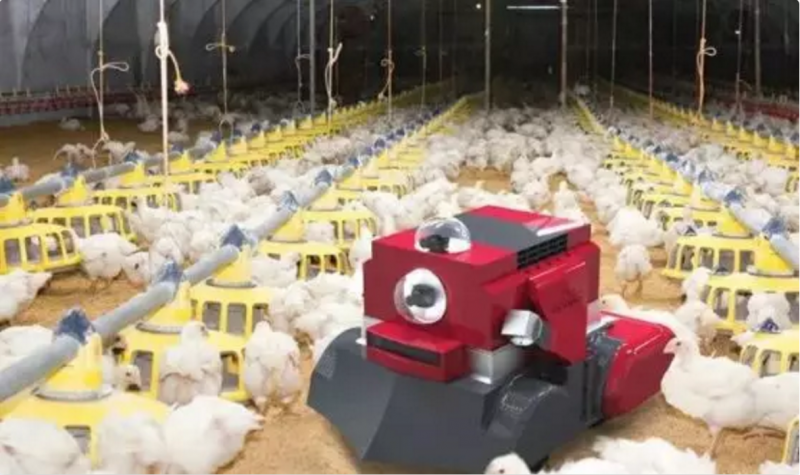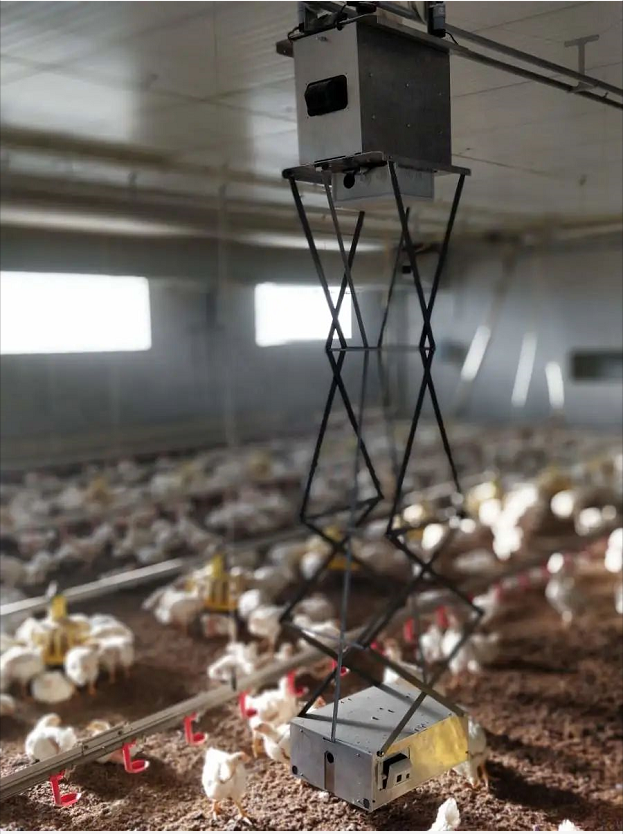Fan Cheng A group of employees have liberated chickens, and another group of robots have come to
Published on:2020-04-21
Two poultry house robots have been launched abroad. They aim to provide new methods to improve poultry and animal welfare, improve production performance and reduce labor demand.
This is the robot gohbot developed by Colin usher of Georgia Institute of technology, which can walk on the floor of the poultry house. This robot uses imaging sensors for navigation and can detect and pick up eggs on the floor.
Heiner lehr of farm robotics and automation SL showed a robot that can be suspended from the ceiling of the poultry house on the official website. This robot is equipped with sensors and can monitor the condition of the poultry house and birds at the same time. Faromatics is a new start-up company that brings high technology into animal husbandry. By continuously monitoring animals, their goal is to quickly and reliably discover animal needs.

The chickenboy is the worlds first roof suspended robot to observe the machine. The robot monitors air quality, health and welfare through a variety of sensors and cameras, checks the operation of the equipment, and notifies farmers, herdsmen or veterinarians through mobile alarms.
Artificial intelligence and sensor navigation robot
Gohbot is a robot that can walk intelligently in a commercial poultry house. It can interact with chickens and perform some tasks, such as picking up eggs on the floor. Gohbot is equipped with artificial intelligence programs and a set of sensors, including 2D and 3D electronic image recorders and infrastructure to support walking in the poultry house. AI programs allow robots to identify chickens, devices and locate eggs on the floor.
"What we envision is a robot living in a poultry house that can assess the state of the flock 24 hours a day and remove eggs and / or dead chickens from the floor," said the developer of Georgia Institute of technology
Chickenboy makes data access easier
The chickenboy ceiling automatic robot can move on a simple track inside the poultry house to monitor the management problems of the poultry house, including detecting health problems, locating dead birds, detecting bedding problems and measuring the surrounding environmental conditions.
Users can obtain this information from the dashboard through the cloud platform:
1. Farmers use this information to improve animal welfare and production efficiency.
2. Vertically integrated enterprises can better monitor the growth of animals.
3. Veterinarians and consultants can improve their services with more and faster data from farms.
4. Researchers and product developers can obtain relevant data and test and develop new sensors and algorithms in third-party expansion modules.

Robots enter poultry farms
"Robots on poultry farms are really new. At present, only a handful of poultry farms use robots. The total number is only about 20-30," said lehr of faromatics.
Usher of Georgia Institute of technology also said, "at present, there are few robot systems used in the poultry breeding sector, because the relevant technologies are relatively new, and in some cases, these technologies are too expensive for farmers to afford."
Lehr and usher jointly predicted that the application of poultry house robots will increase rapidly in the next seven years.
"What we imagine is that things will change a lot by 2025," lehr said. "We estimate that 20% - 30% of the leading farms will use robots for operation. If the trend of vertical integration continues, it will be easier for the proportion of robot applications to rise. Usher believes that the application of farm robots will progress more rapidly if large-scale poultry integrators are added. "We believe that by 2025, most forward-looking small producers will adopt such technology, and 20% - 25% of farms will use a robot. If larger vertical integration enterprises force the use of robots, this number will increase to 50% - 75%," he said.
How do farm robots work? Where?
Lehr predicts that robots in the future will perform many different tasks:
1. Observe chickens and provide farmers with the best breeding suggestions
2. Identify most or all key farm performance indicators
3. Collect missing eggs and dead chickens, and even take seriously ill chickens to the farm hospital area.
4. Contribute to the intelligent, personalized and fully automated management of climate, water and feed
Usher said that all areas of the poultry industry have a strong interest in the performance of robots. "Considering the functions brought by robots, such as automatic floor egg picking, we think cageless laying hens and breeding houses will take the lead in adopting robot technology. Broiler farms may adopt such technology later," he said
"I believe the adoption rate of animal husbandry robots will be close to 90% in 10-20 years," usher predicted. Could it be earlier? I think robot technology is still relatively new and needs to be popularized and proved in practice to stabilize its position in the industry. "
This is the robot gohbot developed by Colin usher of Georgia Institute of technology, which can walk on the floor of the poultry house. This robot uses imaging sensors for navigation and can detect and pick up eggs on the floor.
Heiner lehr of farm robotics and automation SL showed a robot that can be suspended from the ceiling of the poultry house on the official website. This robot is equipped with sensors and can monitor the condition of the poultry house and birds at the same time. Faromatics is a new start-up company that brings high technology into animal husbandry. By continuously monitoring animals, their goal is to quickly and reliably discover animal needs.

The chickenboy is the worlds first roof suspended robot to observe the machine. The robot monitors air quality, health and welfare through a variety of sensors and cameras, checks the operation of the equipment, and notifies farmers, herdsmen or veterinarians through mobile alarms.
Artificial intelligence and sensor navigation robot
Gohbot is a robot that can walk intelligently in a commercial poultry house. It can interact with chickens and perform some tasks, such as picking up eggs on the floor. Gohbot is equipped with artificial intelligence programs and a set of sensors, including 2D and 3D electronic image recorders and infrastructure to support walking in the poultry house. AI programs allow robots to identify chickens, devices and locate eggs on the floor.
"What we envision is a robot living in a poultry house that can assess the state of the flock 24 hours a day and remove eggs and / or dead chickens from the floor," said the developer of Georgia Institute of technology
Chickenboy makes data access easier
The chickenboy ceiling automatic robot can move on a simple track inside the poultry house to monitor the management problems of the poultry house, including detecting health problems, locating dead birds, detecting bedding problems and measuring the surrounding environmental conditions.
Users can obtain this information from the dashboard through the cloud platform:
1. Farmers use this information to improve animal welfare and production efficiency.
2. Vertically integrated enterprises can better monitor the growth of animals.
3. Veterinarians and consultants can improve their services with more and faster data from farms.
4. Researchers and product developers can obtain relevant data and test and develop new sensors and algorithms in third-party expansion modules.

Robots enter poultry farms
"Robots on poultry farms are really new. At present, only a handful of poultry farms use robots. The total number is only about 20-30," said lehr of faromatics.
Usher of Georgia Institute of technology also said, "at present, there are few robot systems used in the poultry breeding sector, because the relevant technologies are relatively new, and in some cases, these technologies are too expensive for farmers to afford."
Lehr and usher jointly predicted that the application of poultry house robots will increase rapidly in the next seven years.
"What we imagine is that things will change a lot by 2025," lehr said. "We estimate that 20% - 30% of the leading farms will use robots for operation. If the trend of vertical integration continues, it will be easier for the proportion of robot applications to rise. Usher believes that the application of farm robots will progress more rapidly if large-scale poultry integrators are added. "We believe that by 2025, most forward-looking small producers will adopt such technology, and 20% - 25% of farms will use a robot. If larger vertical integration enterprises force the use of robots, this number will increase to 50% - 75%," he said.
How do farm robots work? Where?
Lehr predicts that robots in the future will perform many different tasks:
1. Observe chickens and provide farmers with the best breeding suggestions
2. Identify most or all key farm performance indicators
3. Collect missing eggs and dead chickens, and even take seriously ill chickens to the farm hospital area.
4. Contribute to the intelligent, personalized and fully automated management of climate, water and feed
Usher said that all areas of the poultry industry have a strong interest in the performance of robots. "Considering the functions brought by robots, such as automatic floor egg picking, we think cageless laying hens and breeding houses will take the lead in adopting robot technology. Broiler farms may adopt such technology later," he said
"I believe the adoption rate of animal husbandry robots will be close to 90% in 10-20 years," usher predicted. Could it be earlier? I think robot technology is still relatively new and needs to be popularized and proved in practice to stabilize its position in the industry. "

